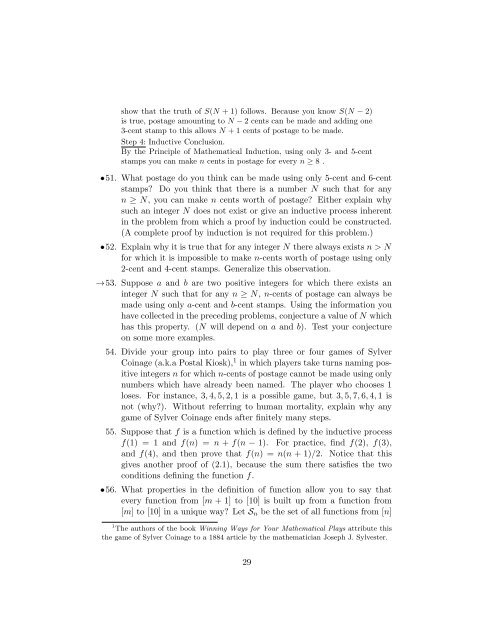DISCRETE MATHEMATICS THROUGH GUIDED DISCOVERY ...
DISCRETE MATHEMATICS THROUGH GUIDED DISCOVERY ...
DISCRETE MATHEMATICS THROUGH GUIDED DISCOVERY ...
Create successful ePaper yourself
Turn your PDF publications into a flip-book with our unique Google optimized e-Paper software.
show that the truth of S(N + 1) follows. Because you know S(N − 2)<br />
is true, postage amounting to N − 2 cents can be made and adding one<br />
3-cent stamp to this allows N + 1 cents of postage to be made.<br />
Step 4: Inductive Conclusion.<br />
By the Principle of Mathematical Induction, using only 3- and 5-cent<br />
stamps you can make n cents in postage for every n ≥ 8 .<br />
•51. What postage do you think can be made using only 5-cent and 6-cent<br />
stamps? Do you think that there is a number N such that for any<br />
n ≥ N, you can make n cents worth of postage? Either explain why<br />
such an integer N does not exist or give an inductive process inherent<br />
in the problem from which a proof by induction could be constructed.<br />
(A complete proof by induction is not required for this problem.)<br />
•52. Explain why it is true that for any integer N there always exists n > N<br />
for which it is impossible to make n-cents worth of postage using only<br />
2-cent and 4-cent stamps. Generalize this observation.<br />
→53. Suppose a and b are two positive integers for which there exists an<br />
integer N such that for any n ≥ N, n-cents of postage can always be<br />
made using only a-cent and b-cent stamps. Using the information you<br />
have collected in the preceding problems, conjecture a value of N which<br />
has this property. (N will depend on a and b). Test your conjecture<br />
on some more examples.<br />
54. Divide your group into pairs to play three or four games of Sylver<br />
Coinage (a.k.a Postal Kiosk), 1 in which players take turns naming positive<br />
integers n for which n-cents of postage cannot be made using only<br />
numbers which have already been named. The player who chooses 1<br />
loses. For instance, 3, 4, 5, 2, 1 is a possible game, but 3, 5, 7, 6, 4, 1 is<br />
not (why?). Without referring to human mortality, explain why any<br />
game of Sylver Coinage ends after finitely many steps.<br />
55. Suppose that f is a function which is defined by the inductive process<br />
f(1) = 1 and f(n) = n + f(n − 1). For practice, find f(2), f(3),<br />
and f(4), and then prove that f(n) = n(n + 1)/2. Notice that this<br />
gives another proof of (2.1), because the sum there satisfies the two<br />
conditions defining the function f.<br />
•56. What properties in the definition of function allow you to say that<br />
every function from [m + 1] to [10] is built up from a function from<br />
[m] to [10] in a unique way? Let Sn be the set of all functions from [n]<br />
1 The authors of the book Winning Ways for Your Mathematical Plays attribute this<br />
the game of Sylver Coinage to a 1884 article by the mathematician Joseph J. Sylvester.<br />
29

















